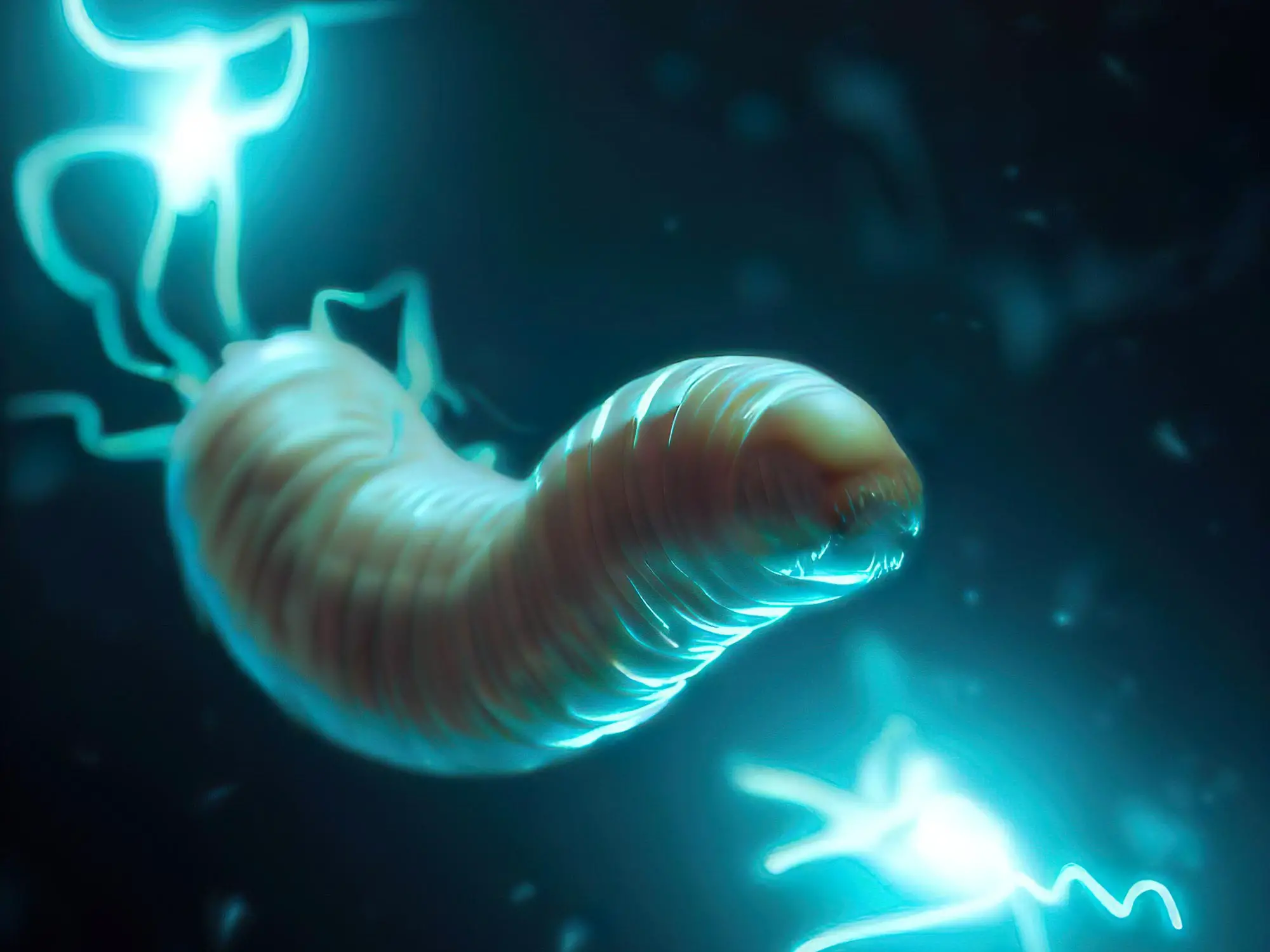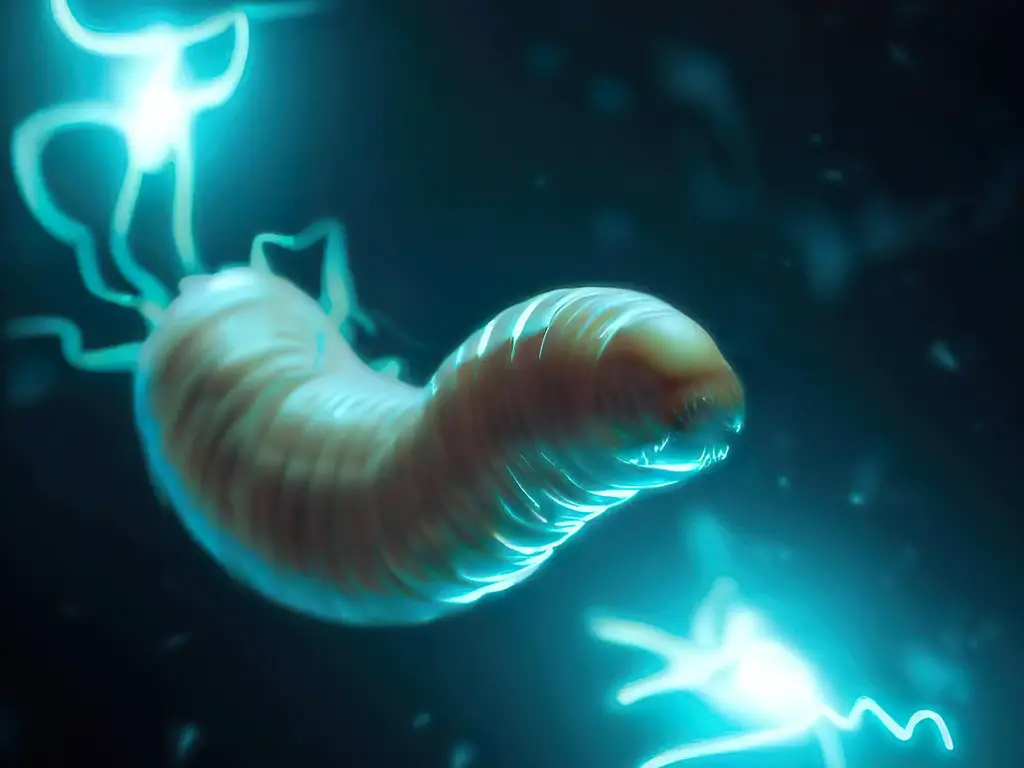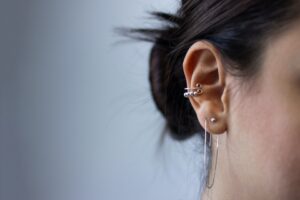

A new study reveals that microscopic worms, Caenorhabditis elegans, can use electric fields to “jump” onto electrically charged objects, such as bumblebees, essentially hitching a ride. This breakthrough discovery provides a link between their known behavior of attaching to insects for transportation and the previously unexplained method of how they can traverse such large distances relative to their size. (Artist’s concept.)
In the natural world, small animals frequently latch onto larger beings and “hitch a ride” to conserve energy while traversing great distances.
A study recently published in the journal Current Biology reveals that minuscule Caenorhabditis elegans worms have the capacity to utilize electric fields to “leap” across Petri dishes or onto insects. This capability enables them to glide in the air and attach themselves, for example, onto naturally charged bumblebee chauffeurs.
“Pollinators, such as insects and hummingbirds, are known to be electrically charged, and it is believed that pollen is attracted by the electric field formed by the pollinator and the plant,” says Takuma Sugi, a biophysics professor at Hiroshima University and co-senior author on the study. “However, it was not completely clear whether electric fields are utilized for interactions between different terrestrial animals.”
A worm jumps onto a bumblebee along an electrical field. Credit: Current Biology/Chiba et al.
The researchers first began investigating this project when they noticed that the worms they cultivated often ended up on the lids of Petri dishes, opposite to the agar they were placed on. When the team attached a camera to observe this behavior, they found that it was not just because worms were climbing up the walls of the dish. Instead, they were leaping from the floor of the plate to the ceiling.
Suspecting travel by electric field, the researchers placed worms on a glass electrode and found that they only leaped to another electrode once charge was applied. Worms jumped at an average speed of .86 meters per second (close to a human’s walking speed), which increased with electric field intensity.
Next, the researchers rubbed flower pollen on a bumblebee so that it could exhibit a natural electric charge. Once close to these bees, worms stood on their tails, then jumped aboard. Some worms even piled on top of each other and jumped in a single column, transferring 80 worms at once across the gap.
A cluster of worms leap together. Credit: Current Biology/Chiba et al.
“Worms stand on their tail to reduce the surface energy between their body and the substrate, thus making it easier for themselves to attach to other passing objects,” Sugi says. “In a column, one worm lifts multiple worms, and this worm takes off to transfer across the electric field while carrying all the column worms.”
C. elegans is known to attach to bugs and snails for a ride, but because these animals don’t carry electric fields well, they must make direct contact to do so. C. elegans is also known to jump on winged insects, but it was not clear how the worms were traversing such a significant distance for their microscopic size.
This research makes the connection that winged insects naturally accumulate charge as they fly, producing an electric field that C. elegans can travel along.
It’s unclear exactly how C. elegans performs this behavior. The worms’ genetics might play a role. Researchers observed jumping in other worm species closely related to C. elegans, and they noted that mutants who are unable to sense electric fields jump less than their normal counterparts.
However, more work is needed to determine exactly what genes are involved in making these jumps and whether other microorganisms can use electricity to jump as well.
Reference: “Caenorhabditis elegans transfers across a gap under an electric field as dispersal behavior” by Takuya Chiba, Etsuko Okumura, Yukinori Nishigami, Toshiyuki Nakagaki, Takuma Sugi and Katsuhiko Sato, 21 June 2023, Current Biology.
DOI: 10.1016/j.cub.2023.05.042
The study was funded by the Office for the Promotion of Nanotechnology Collaborative Research, the Japan Science Society, the Consortium Office for the Fostering of Researchers in Future Generations, Hokkaido University, the JSPS Core-to-Core Program, the Research Program of Five-star Alliance in NJRC Mater. & Dev, the Japan Society for the Promotion of Sciences, and the Japan Agency for Medical Research and Development.

